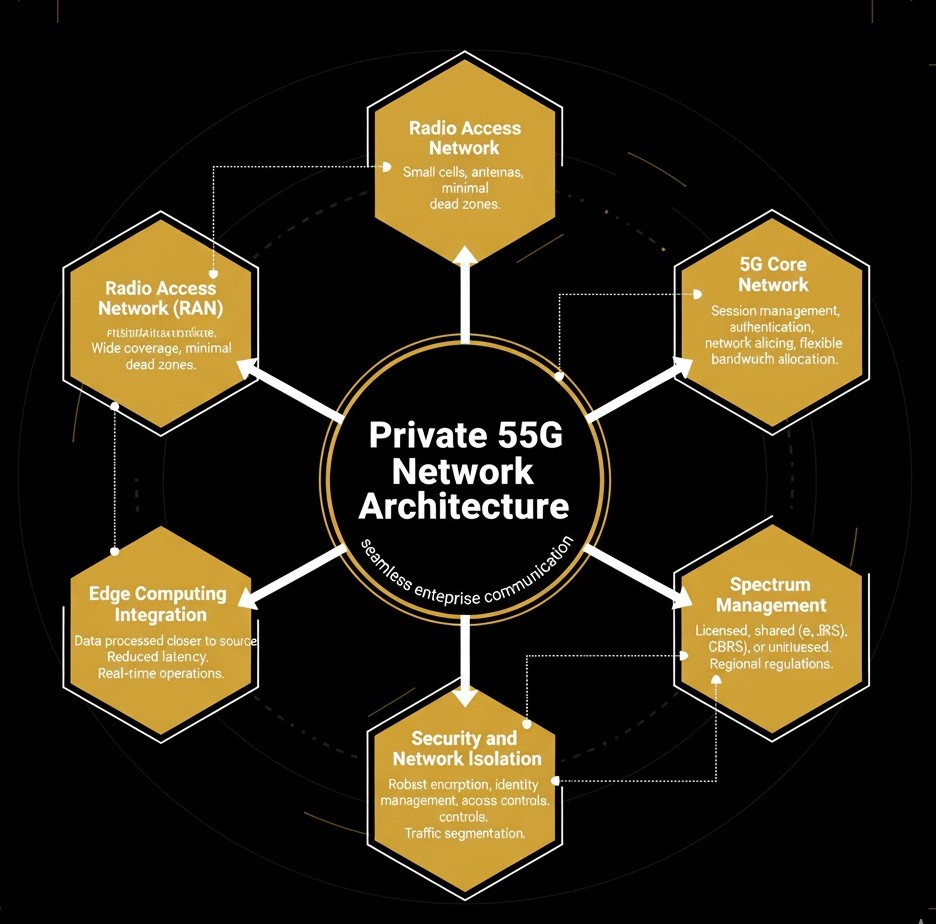October 16, 2025

In today’s fast-paced digital landscape, enterprises in industries like manufacturing, logistics, healthcare, education, and energy are demanding networks that deliver more than basic connectivity. They need systems that enable automation, protect data, and scale alongside emerging technologies. Private 5G network architecture has become the cornerstone of that transformation, offering tailored, secure, and high-performance connectivity that goes far beyond what public networks or Wi-Fi can provide.
Unlike public 5G, private networks give organizations complete control over their connectivity. This control allows for seamless integration with edge computing and IoT ecosystems, creating low-latency environments ideal for smart operations.
This comprehensive guide explores the design, components, benefits, and deployment strategies behind private LTE and 5G networks. It helps CIOs, CTOs, and IT leaders understand how to build and scale private cellular systems while learning from real-world examples in logistics, manufacturing, and healthcare.
A private 5G network architecture is a dedicated cellular environment built for a single organization. It provides secure, high-speed connectivity customized for enterprise operations. Unlike public networks managed by telecom carriers, private 5G ensures that data stays within the organization’s domain, enhancing privacy, reliability, and performance.
Private 5G networks consist of three main layers:
These components work together to deliver fast, secure, and uninterrupted service across enterprise facilities.
For example, CJ Logistics implemented a private 5G network in a 40,000-square-meter warehouse. The company replaced over 300 Wi-Fi access points with just 22 small cells, achieving higher reliability, reduced interference, and lower maintenance costs. Productivity increased by 20 percent, and operational efficiency improved across the entire site.
Similarly, Alcatel Submarine Networks (ASN) deployed Europe’s largest private industrial 5G network across 50,000 square meters and 11 buildings. The network’s low-latency performance allowed ASN to monitor production processes in real time and implement predictive maintenance strategies, significantly reducing downtime.
These cases show how private 5G architecture translates directly into measurable business outcomes.
Building a strong private 5G network depends on integrating several essential components that work together for seamless enterprise communication.
The RAN enables wireless connectivity through small cells, antennas, and distributed radios. It supports wide coverage with fewer physical access points, minimizing dead zones even in large industrial spaces.
The 5G Core governs session management, authentication, and network slicing. It provides the flexibility to allocate bandwidth based on use cases, such as prioritizing robotics control or automated inspection systems.
Edge computing allows data to be processed closer to its source, reducing latency and bandwidth strain. This capability is vital for real-time operations in manufacturing, logistics, and healthcare settings. ASN’s private 5G network, for example, supports analytics at the factory floor, allowing systems to identify issues before they cause production delays.
Private networks can use licensed, shared, or unlicensed spectrum depending on regional regulations. In the United States, the Citizens Broadband Radio Service (CBRS) band is a popular shared spectrum for enterprise private networks, offering reliable connectivity without heavy licensing costs.
Private 5G networks are built with robust encryption, identity management, and access controls to ensure secure communication. They also provide traffic segmentation, keeping sensitive operational data isolated from other network activities.
Together, these components form the backbone of a resilient, scalable private 5G network designed for long-term enterprise needs.

When compared to Wi-Fi, private 5G delivers significant advantages in coverage, reliability, and scalability.
Coverage and Reliability: Private 5G networks cover large areas with fewer access points and stronger signal consistency. In CJ Logistics’ case, fewer than two dozen small cells replaced hundreds of Wi-Fi units while achieving greater throughput and stability.
Latency and Interference: Private 5G maintains latency below ten milliseconds, ideal for robotics and automated machinery. Wi-Fi, by contrast, often struggles with interference and fluctuating performance.
Mobility and Handover: Devices can move seamlessly between cells in a private 5G setup without dropped connections, making it ideal for mobile robots and handheld scanners in logistics and manufacturing environments.
Security and Scalability: Built-in encryption, SIM-based authentication, and dedicated bandwidth ensure that private 5G networks remain secure even as the number of connected devices grows.
For enterprises that depend on uninterrupted operations, private 5G offers the reliability and control Wi-Fi cannot match.
Although both technologies use similar infrastructure, private 5G differs from public 5G in several key ways.
These differences make private 5G ideal for businesses that prioritize control, security, and performance.
Successful private 5G deployments rely on a strong ecosystem of providers and integrators.
Major Equipment Providers: Companies like Nokia, Ericsson, Cisco, AWS, and Dell Technologies supply the hardware and software needed for private 5G networks. For example, ASN’s large-scale deployment was supported by Nokia, which provided the radio and core infrastructure for secure industrial operations.
Specialized Private Cellular Providers: Vendors such as Celona and Mavenir offer flexible private LTE and 5G solutions tailored for specific enterprise environments.
System Integrators and Managed Service Providers: These partners design and manage private 5G solutions, ensuring that the network integrates seamlessly with existing IT and operational systems.
Metro Wireless serves as a leading private cellular network provider focused on custom enterprise solutions. The company delivers private 5G deployment, lifecycle management, and edge integration services without locking clients into a single vendor ecosystem.
Private 5G networks deliver measurable benefits across every industry:
While private 5G offers unmatched benefits, implementation requires strategic planning to overcome key challenges:
Working with experienced system integrators and managed service providers helps organizations mitigate these challenges effectively.
Private 5G is rapidly evolving, shaping the next era of enterprise connectivity. Key trends include:
These trends ensure that private 5G remains adaptable and relevant as digital transformation accelerates.
What is the architecture of a private 5G network?
It includes a dedicated RAN, 5G core, edge computing, and security framework managed by the enterprise.
How is private 5G different from Wi-Fi?
Private 5G provides greater reliability, lower latency, and stronger security for enterprise environments.
Who are the top private 5G network providers?
Nokia, Ericsson, Cisco, AWS, Dell Technologies, and Metro Wireless are among the leaders in this space.
Can enterprises build their own private 5G network?
Yes. With shared spectrum options like CBRS and modular vendor solutions, organizations can deploy and manage their own networks.
What are the benefits of private 5G for industrial automation?
It enables real-time control, predictive maintenance, and seamless IoT integration for smart manufacturing.
Is private 5G better than Wi-Fi 6 for enterprise use?
For mission-critical operations, yes. Private 5G delivers consistent performance, better mobility, and stronger isolation.
What’s next for private 5G networks?
Expect continued integration with AI, automation, and cloud-edge infrastructure, driving toward self-optimizing, autonomous network environments.
Private LTE and 5G network architectures are no longer emerging technologies. They are redefining enterprise connectivity today. The results from CJ Logistics and Alcatel Submarine Networks demonstrate the real-world potential of private 5G in improving performance, security, and efficiency.
Metro Wireless helps organizations design, deploy, and manage private cellular networks that meet modern enterprise demands. To future-proof your connectivity and gain full control of your network infrastructure.
Connect with Metro Wireless today and start your journey toward next-generation enterprise performance.

Tyler Hoffman
CEO
